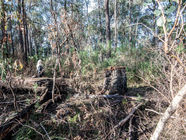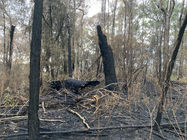
Gippsland Environment Group Inc
Lobbying against environmental threats on the unceded lands of the GunaiKurnai, Yaitmathang, Ngarigo and Bidwell Peoples
Mt Alfred State Forest
Forest Fire Management VIC burning the Special Protection Zone
Two burns together: Wattle Ck Rd + Kill Me Dead Tk
April 2024 - updated 21-05-2025
With recent records of Greater gliders, Yellow-bellied gliders, Powerful owls, Sooty owls, Long-nosed bandicoots, Koalas and Yellow-bellied glider feed trees
Two Forest Fire Management Victoria (FFMV) planned burns, lit together 01-04-2024
673ha Planned burn Mt Alfred – Wattle Ck Rd GP GP-TBO-BAI-0017
492ha Planned burn Mt Alfred – Kill Me Dead Ck Tk GP-TBO-BAI-0007
Total area: 1,165 HA
Perimeter ignition (both burns) 06-04-2023 | Major internal burn area (both burns) ignition 01-04-2024
Background
On GunaiKurnai Country, the Mt Alfred State Forest shares a western boundary with the Mitchell River National Park while the eastern and southern edges border long cleared farmland. A Special Protection Zone overlay, recognising the biodiversity values of this particular part of the forest, covers nearly all of these two planned burn sites (see map below). Warm temperate rainforest, old growth forest and large forest owls are all in this Special Protection Zone.
Gippsland Environment Group (GEG) have surveyed and submitted records to FFMV of threatened fauna and flora within these two planned burns sites since 2016. GEG records included Yellow-Bellied Gliders Petaurus australis (VU EPBC) Greater Gliders Petauroides volans (EN EPBC) evidence of Powerful Owls Ninox strenua (VU FFG) feeding on gliders, Yellow-bellied Glider feed trees, and a significant number of hollow-bearing trees
Also recorded in this forest are Sooty Owls Tyto tenebricosa (EN FFG), Powerful Owls Ninox strenua , Long-nosed Bandicoots Perameles nasuta, Koalas Phascolarctos cinereus. Other records include nationally endangered Giant burrowing frogs Heleioporus australiacus (EN EPBC).
Below: Some of the many gliders recorded in the burn area

The most recent fauna survey was by the Victorian Forest Alliance team in November 2023. Over just two survey nights, nine Yellow-Bellied Gliders and twelve Greater Gliders were recorded in the Wattle Ck Rd burn. Other records included Long-nosed Bandicoots and Koalas
The VFA survey report urgently recommended FFMV remove the Wattle Ck Rd burn and the adjacent Mt Alfred – Kill Me Dead Ck Tk burn from the schedule and/or refer the burn to the Federal Government as a Controlled Action under the EPBC Act, acknowledging the serious threat to listed species and their habitat.
Greater Gliders are listed as Endangered (EPBC) and Yellow-bellied Gliders as Vulnerable (EPBC), both species depend on large old hollow trees for den sites.
The Department of the Environment’s Conservation Advice for both species identifies planned burns as a key threat, not only causing direct mortality, but also the destruction of glider habitat trees used for denning. Research by DELWP Report No:95 (Bluff 2016) identified that hollow bearing trees in planned burns were 28 times more likely to collapse than in unburnt areas.
Despite all the significant values and requests for FFMV to remove the burns or refer them to the Federal Government as Controlled Actions, FFMV proceeded to light them up, and they ignited two burns, side by side 1165Ha at the same time. The burn plan mitigation for Greater Gliders was to aim for 50% coverage!
See photos below for what happened.
Post burn survey observations - perimeter burn April 2023
Roadside tree removal works cut down very large old hollow bearing trees along the entire perimeter of the burn. The perimeter burn (April 2023) destroyed many old hollow trees.
Below: Old hollow trees felled and burnt along the entire perimeter.
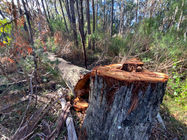
The perimeter burn (April 2023) destroyed significant large old red stringybarks Eucalyptus macrorhyncha. The red stringybarks in this area had flowered for the first time in twelve years and were laden with fruit. Red stringybark seed is a preferred food source of Gang-Gang cockatoos (EN EPBC).
Below: Red stringybarks felled by perimeter burn April 2023
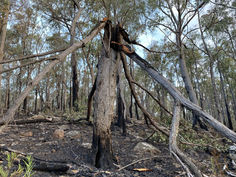
Post burn survey observations - Major interior burn April 2024
The major interior burn was ignited April 2024
Below: 01-04 2024

Post burn survey observations - major interior burn April 2024
The major interior burn caused extensive damage across burnt areas and total collapse occurred to large numbers of big old hollow trees. More roadside trees were bulldozed and cut down. Fire burnt down into riparian zones on Wattle Creek.
Crown scorch has occurred over large areas and is visible from the satellite (see image above).
Below: 2024 in the survey areas of the two burn sites.
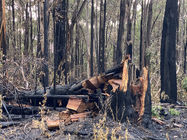
Take Action
Ask for independent oversight and protection of biodiversity in planned burns
Fire management planning is happening, without independent oversight with the Department self-assessing and evaluating their own operations. FFMV do not monitor the efficacy of their planned burns in preventing bushfires.
In Victoria there is no mandatory Code for protection of biodiversity values in planned burn operations that takes into account obligations under the EPBC Act
There is no publicly available information on how operations are planned and how impact on threatened species is minimised and avoided
FFMV do no on- ground pre or post-burn survey for fauna, flora or habitat
FFMV rely on desktop data from the Victorian Biodiversity Atlas in planning which is outdated and does not show most recent records. This was highlighted by the Victorian Auditor-General’s Office’s report Protecting Victoria’s Biodiversity (2021)
According to the Victorian Auditor General’s report Reducing Bushfire Risks. Victorian Auditor General (2020). “With the exception of some isolated case studies, DELWP does not know the effect of its burns on native flora and fauna”
Re efficacy of planned burns in preventing bushfires:
“We’ve understood for a long time now that logging can make bushfires worse, but it’s only in the last few years that evidence is showing that prescribed burning could be doing the same thing,” lead researcher Professor David Lindenmayer, ANU
Contact those responsible
Ask them to put independent oversight in place and regulate impacts using up-to-date science.
You can send also send an email HERE https://vnpa.org.au/action-minister-give-native-forests-proper-oversight/
Steve Dimopoulos MP – State Min for Environment
Email: reception.dimopoulos@ecodev.vic.gov.au
Phone: 03 862 43101
Jacinta Allan – Premier of Victoria
Email: jacinta.allan@parliament.vic.gov.au
Phone: 03 9651 5000
Vicki Ward Minister for Emergency Services
Email: vicki.ward@parliament.vic.gov.au
Phone: 1300 358 704
Murray Watt – Federal Min for Environment
Email: Minister.Watt@dcceew.gov.au
Phone: 02 6277 7920
Office of Conservation Regulator, Kate Gavens
Email: conservationregulator@deeca.vic.gov.au









